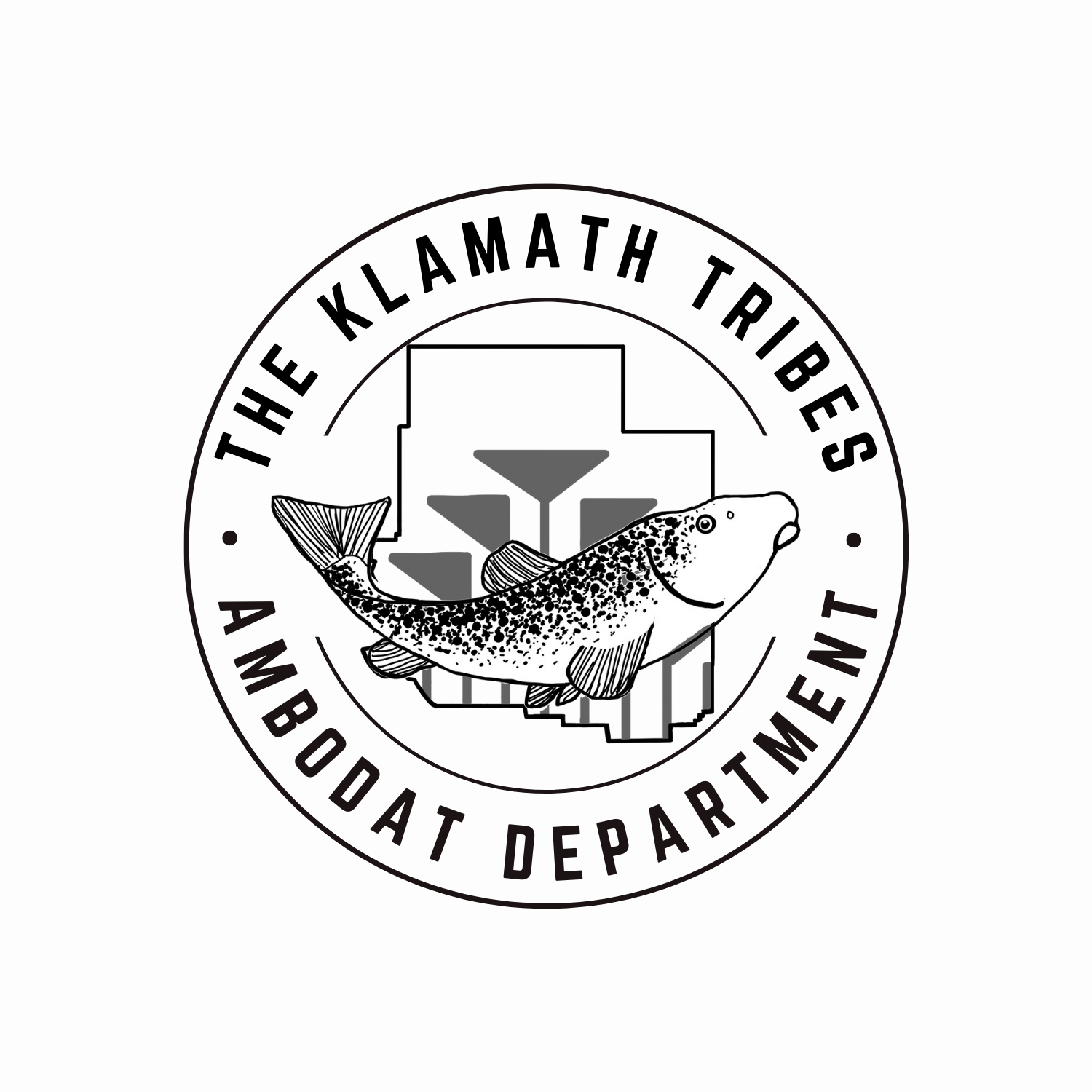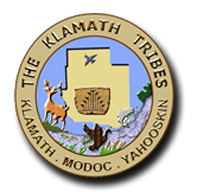Ambodat

Mark Buettner
Ambodat Director
Office Location:
5671 Sprague River Hwy
Chiloquin, Or 97624
Staff:
Email Mark Buettner
Ambodat Director
541-783-2219 ext. 227
Email Kaneeta Kirk
Ambodat Office Manager
541-783-2219 ext. 221
Email Teresa Coley
Ambodat Lead Chemist
541-783-2219 ext. 243
Email Carlie Sharpes
Aqua culturist
541-783-2219 ext. 242
Email Brad Parrish
Water Right Specialist
541-783-2219 ext. 243
Email Shahnie Rich
Environmental Scientist
541-783-2219 ext. 230
Email Lottie Riddle
Restoration Project Manager
541-783-2219 ext. 238

Ambodat
Ambodat: Meaning in, at, or near the water.
Mission Statement: Implement programs to restore and enhance the aquatic resources upon which the Tribal Members depend for their livelihood.
Vision Statement: Aquatic ecosystems within the Treaty Boundaries are restored to the point where traditional Treaty Resources are available to the Tribal Members in abundance.
Department Overview
The Klamath Tribes Ambodat Department (AD; formerly Aquatic Resources Department) has existed since the late 1980’s focusing on aquatic resource management in the Upper Klamath Basin within the former reservation. The AD includes staff that run the Sprague River Water Quality Lab, develop and implement ecosystem restoration projects on private and public lands, conduct water quality monitoring in Upper Klamath Lake and its tributaries, operate an indoor hatchery and outdoor ponds for rearing endangered suckers (and soon salmon), conduct fish population monitoring, perform water rights monitoring and compliance, and conduct surface and groundwater monitoring and hydrological modeling. AD employees also are involved in interagency coordination related to operation of the US Bureau of Reclamation’s Klamath Irrigation Project, Oregon Department of Environment Quality’s Total Maximum Daily Load efforts, planning for salmon reintroduction in the Upper Klamath Basin, consulting with the US Forest Service on management of Fremont-Winema National Forest, and working with Oregon Department of Agriculture on planning and implementation of sediment and nutrient load reduction projects on private lands. The AD is housed at the Klamath Tribes Research Station located 5 miles east of Chiloquin and has 25 permanent and seasonal employees.

Ambodat Department Programs
Sprague River Water Quality Lab (SRWQL):
- The Sprague River Water Quality Lab (SRWQL) has been in operation since 2006. The SRWQL participates in the Chesapeake Bay Project’s inter-laboratory comparison study biannually, and the USGS’s Suspended Sediment Concentration inter-laboratory comparison study annually. The lab has been accredited for 9 of its current 19 analytes through the Oregon Environmental Laboratory Accreditation Program (ORELAP) since 2017. The lab not only analyzes all of the water quality samples for the Klamath Tribes Water Quality Monitoring Program, but also analyzes environmental water quality samples for multiple external clients, including USGS, the Bureau of Land Management, the Bureau of Reclamation, USFWS in partnership with the Klamath Watershed Partnership, Resource Environmental Solutions (contractor managing the Klamath River Dam Removal Project), the Yurok Tribe, and Confederated Tribes of the Grand Ronde.
- The SRWQL utilizes state-of-the-art automated technology with the Thermo Fisher Gallery Plus discrete analyzer (GP1). The SRWQL performs analyses of 19 analytes in-house; nutrients (Total Phosphorus, Particulate Organic Phosphorus, Total Dissolved Phosphorus, Orthophosphate, Total Nitrogen, Nitrite, Nitrate, Nitrite+Nitrate, Ammonia, and Silica), Turbidity, Total Suspended Solids, Volatile Suspended Solids, Settleable Solids, Suspended Sediment Concentration, Chlorophyll-a, Phaeophytin-a, Microcystin toxicity, and Alkalinity. Analyses requested by our client that the SRWQL does not perform in-house are preserved here and shipped to other commercial labs for analyses. The lab also uses E-friendly methods that employ chemicals that are less toxic to the environment.
Water Quality Monitoring
- The AD water quality technicians have been collecting water samples from Upper Klamath Lake (UKL) since 1988, and in the tributaries since 2001. Currently UKL sampling occurs every two weeks during the growing season (May through October). In situ data is collected at 11 established sites in UKL for depth, temperature, conductivity, pH, and dissolved oxygen. Depth-integrated water samples are collected for lab analyses of nutrients (Total Phosphorus, Total Dissolved Phosphorus, Orthophosphate, Total Nitrogen, Ammonia, Nitrate+Nitrite, Nitrite, Silica), Chlorophyll a, and Phaeophytin a at all 11 sites. Additional samples are collected monthly for microcystin analysis at nine sites during the growing season only. Between growing seasons (October through May), UKL is sampled monthly at only one station, near the outlet of the lake.
- Bi-weekly nutrient loading monitoring of the UKL tributaries is conducted year-round. A total of 15 sites are sampled in two watersheds; seven sites in the Wood/Williamson River watershed and eight sites in the Sprague River watershed. In situ data collection includes temperature, conductivity, pH, DO, discharge, and flow velocity. Water samples are collected for lab analyses of nutrients (see above) and water clarity (Turbidity and Total Suspended Solids). Additional sampling occurs during high flow events that may move large amounts of sediments and nutrients downriver.
- Annual reports on tributary nutrient loading to the UKL are performed by a tribal consultant (Dr. Jacob Kann, Aquatic Ecosystem Sciences). The Tribes’ ongoing watershed water quality monitoring effort has provided an invaluable water quality record that will benefit efforts to aid endangered sucker recovery and salmon reintroduction in the Upper Klamath Basin. The water quality monitoring not only provides baseline environmental conditions in the watershed but also allows us to evaluate restoration and management actions addressing water quality issues.
Fisheries
- The Tribes’ fisheries biologist, aquaculturist, and fisheries resource technicians are responsible for sucker rearing activities, conducting fish and other aquatic species monitoring activities, and providing technical support for reviewing state and federal government agency reports and plans that potentially affect tribal aquatic resources. This program also includes monitoring fish population status within the former reservation, conducting fish die-off investigations, developing and implementing a nonnative fish control program, assisting with a US Fish and Wildlife Service juvenile sucker radio tracking study, and working with Oregon Department of Fish and Wildlife on a salmon reintroduction plan for the Upper Klamath Basin to occur after four Klamath River dams are removed in 2024.
Sucker Rearing Program
- Our creation story tells us that if the C’waam go away, the people go away. C’waam, also known as Lost River suckers, can weigh over 10 pounds, reach three feet long, and live for up to 50 years. Koptu, or Shortnose suckers, are smaller, usually about 18 inches long, and live for more than 30 years.
- The Klamath Tribes operate and maintain a fish hatchery and rearing ponds. The hatchery constructed in 1995 was used primarily to rear endangered suckers for a variety of research studies to better understand factors affecting their survival and growth. Studies performed over the years using fish reared at the hatchery include: water quality tolerance studies (temperature, DO, pH, ammonia, blue-green algal toxins), disease tolerance, invertebrate predation on sucker eggs, non-native fish predation, and development of improved sucker rearing techniques.
- Beginning in 2018, because of the continued rapid decline of the endangered Lost River and shortnose sucker populations in UKL and lack of successful recruitment for the last 20 years, the Tribes began efforts to rear suckers to supplement wild fish. Wild-caught sucker larvae are captured in the Williamson River during spring and reared at the hatchery for at least two years before release back to UKL. Also, egg collections are taken from small numbers of lake-shore spawning Lost River suckers and river spawning shortnose suckers. The long-term goal is to recover the sucker populations to numbers that will allow tribal harvest. Historically, the suckers were an important food source for the Klamath people.
Water Rights
- The administrative phase of the Klamath Basin Adjudication was completed in 2013 (Klamath Basin Adjudication’s Amended and Corrected Findings of Facts and Order of Determination-ACFFOD). The Klamath Tribes determined senior water rights claims were affirmed. The Oregon Department of Water Resources (OWRD) has been enforcing and regulating Tribal water rights calls since that time. Because OWRD has been challenged to adequately monitor and enforce the Tribes’ senior water rights, the AD Water Rights Specialist has been monitoring stream flow in claim reaches during the irrigation season from April through October. When stream flows are at or below the Tribes determined claim, we report back to the local OWRD Watermaster’s Office for follow-up. The Tribes’ flow monitoring efforts have aided OWRD in more efficiently enforcing and regulating water rights in the Upper Klamath Basin. Additionally the AD Water Rights Specialist represents the Klamath Tribes in various capacities at state and federal levels in protection of the Tribes’ water rights. Further, our staff have provided additional eyes on the ground to identify potential violators.
Hydrology
- The AD Hydrologist and Hydrologic Technician monitor both surface and groundwater in the Klamath Marsh area as well as streamflow in the small creeks of the UKL basin to determine flow interaction, balance, and monitor the changes over time. This effort has been driven by recent data showing that Klamath Marsh water levels and Upper Williamson River flows are much lower than the Tribes’ determined claim levels. A goal of the Klamath Marsh study is to discover sources and mechanisms which produce the area water regime by monitoring local shallow groundwater and open water bodies. The monitoring network includes 16 shallow wells and nine water gauges which were established in 2020, in addition to the five existing streamflow gauges. In addition to monitoring a network of staff gauges and water level loggers, the hydrologist is analyzing current and historical records of surface water and groundwater and water balance analyses. The Tribes are also collaborating with USGS and OWRD on an initial assessment of hydrological information for the Klamath Marsh watershed. The long-term goal is to develop a water balance model of the marsh, along with a watershed model to assess the water availability and opportunities for increasing marsh levels and instream flows.
Habitat Restoration
- The Klamath Tribes have a responsibility to restore and steward tribal treaty resources in the Upper Klamath Basin, including a variety of fish species (i.e., redband trout, Lost River sucker, shortnose sucker). The AD has been developing partnerships with private landowners to conduct riparian and aquatic habitat restoration work in the Tribes’ former reservation since 2017. The Restoration Project Manager, along with the Water Rights Specialist, work collaboratively with Oregon Department of Fish and Wildlife, US Fish and Wildlife Service, Trout Unlimited, and Klamath Watershed Partnership to identify, design, and implement projects. AD staff are actively implementing numerous restoration projects in efforts to restore highly degraded watersheds. Projects include installing instream structures, riparian fencing, off-stream cattle watering systems, fish screens, and riparian vegetation.
- The AD worked with consultants and cooperators including Trout Unlimited, The Nature Conservancy, Klamath Watershed Partnership, US Fish and Wildlife Service, Oregon Department of Environmental Quality and California North Coast Regional Water Quality Control Board on an Upper Klamath Basin Watershed Action Plan (WAP). The WAP is a science-driven plan that guides and prioritizes future restoration projects. It is an accessible and adaptive planning and mapping tool that has full buy-in from all WAP organizational partners, is harmonious with other regional planning efforts, and is accessible to partners while also sensitive to the needs of landowners to sustain their operations and ways of life.The AD Environmental Scientist participated in the development of a Klamath River basin-wide restoration plan called the Integrated Fisheries Restoration and Monitoring Plan. This plan is intended to help agencies and tribes with fisheries management jurisdiction wisely allocate funds and coordinate the most effective fisheries restoration and monitoring work. The Upper Klamath Basin WAP will be a component of the overall plan. This plan was completed in 2023.

